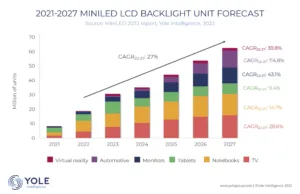Yole Group, PISÉO, and DXOMARK join forces to provide a combined analysis of a disruptive technology that threatens to overshadow OLEDs in the high-end display market.
With a $14 billion investment in miniLEDs between 2019 and 2021, miniLED backlight units seem to be on a huge upswing. Neglected for some time by the high-end display market, mainly dominated by OLEDs, LCDs are back in force with a new technology building block designed to compete with the contrast ratio and image quality provided by OLEDs. By integrating miniLEDs into the backlight unit, a greater number of dimming zones are created, offering finer backlighting control, thus better managing contrast and halo. With this enhanced performance opportunity, LCD manufacturers intend to get a foot in the door of the high-end display market, further facilitated by greater existing manufacturing capacity and lower investment requirements compared to OLEDs.
However, miniLED is still a subject on which display manufacturers struggle to position themselves. Multiple criteria have to be considered to make the most of a miniLED backlight unit.
In this context, Yole Intelligence, Yole SystemPlus, PISÉO, and DXOMARK joined forces and expertise to provide the most complete picture of the topic with several reports targeting display system designers, system architects, and marketing teams. Through in-depth analyses of a selection of four representative displays, the companies teamed up to highlight the technology options adopted by miniLED backlight unit designers and identify the impact on product performance and the supply chain.
For each display, two reports based on teardown analyses are available:
- A technology, process, and cost report powered by Yole SystemPlus that shows the choices in material, backlight unit structure, and driver architecture, as well as the associated estimated costs.
- A performance report powered by PISÉO and DXOMARK (leader in consumer electronics quality assessment) combining an in-depth optical stack teardown and user-based visual performance analysis.
Yole Group and its partners studied the following displays and provide valuable input on key issues:
- TCL MiniLED X9 85” TV backlight Unit: considered a pioneer in miniLED backlighting technology, the Chinese manufacturer TCL is promoting its third generation of miniLED TVs with an OD-zero solution to reduce the thickness of the backlight unit and the screen. It is interesting to see how they do this and whether their experience in the domain will allow them to further extend their technological leadership.
- MiniLED backlight Unit in Samsung’s Neo QLED TV: first to market with LEDs, then with quantum dots, Samsung is eager to take the reins of the high-end TV market and knock LG and its OLED product range off the top of the leaderboard. It is worth taking a look at this unique all-in-one plate construction and its impact on the TV assembly. From a broader point of view, will Samsung manage to close the performance gap with OLED?
- MiniLED backlight unit in Samsung’s Odyssey Neo G9 49’’ Monitor: in a market that OLEDs struggle to enter, it is interesting to focus on Samsung’s technology choices to implement miniLEDs into the so-called first curved miniLED PC monitor and to compare these choices with the Samsung TV.
- MiniLED backlight Unit in the Apple iPad Pro 12.9”: as a leader in the consumer market, all eyes are on Apple’s choices to figure out the market and technology trends. In addition, the successful integration of a miniLED backlight unit in 12.9” displays could accelerate the adoption of the technology by the automotive display market.
- And a technology, process, and cost report of the Skyworth Q72 TV MiniLED with a Chip-on-Glass BSI is also available. Skyworth is the first manufacturer to integrate very large Chip-on-Glass technology for the BSI.

